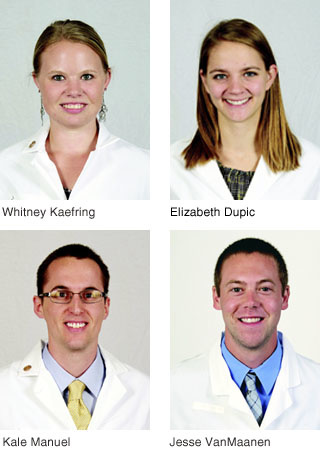
“There are dozens of communities in Iowa with populations of less than 10,000, or even less than 5,000, who need a physician. The odds of finding physicians for these communities are pretty remote, but if we are able to train physicians who have roots in the state, and who are already familiar with rural life, then we can improve those odds dramatically,” says Venteicher, who is serving as a mentor to Kaefring. The four first-year medical students in CRISP are Elizabeth Dupic, of Clarion, Iowa; Whitney Kaefring, of Solon, Iowa; Kale Manuel, of Clarinda, Iowa; and Jesse Van Maanen, of Leighton, Iowa.
With up to 32 million newly insured Americans entering the health care system under the Affordable Care Act, it is estimated there will be a shortage of 90,000 physicians by 2020, according to the Association of American Medical Colleges. In Iowa alone, there are 52 federally designated primary care shortage areas in 56 counties. These areas are mostly in rural Iowa.
“By connecting these students with mentors who are rural physicians, having their rotations in small towns, giving them field experiences in rural medicine, and developing a Rural Medicine Interest Group, we’re sharing with them special features of practicing in a small town so they will be comfortable going into that role,” says Victoria Sharp, M.D. (residency ’98), M.B.A., clinical professor of urology and family medicine, and the director of CRISP.
Sharp notes the college has long been committed to training primary care providers and serving rural communities. Every year, between 40 and 50 percent of the college’s graduates choose medical residency training in primary care specialties such as family medicine, internal medicine, pediatrics, and obstetrics and gynecology.
The college is ranked 10th in the nation by the American Academy of Family Physicians for graduating the greatest percentage of students entering family practice and 10th by the American College of Physicians for accomplishing the social mission of academic medicine—graduating students who practice primary care, work in underserved areas, and represent the diversity of the population. Half of Iowa’s 5,000 doctors did some or all of their training at the University of Iowa.
The latest U.S. News & World Report ranking of the nation’s best graduate schools places the Carver College of Medicine among the top 20 in rural medicine, primary care, family medicine, and internal medicine.
“Four students per year may not sound like much, but in four years we will have 16 individuals who are doing this program and then we can begin to nibble away at the long list of practice opportunities in the state. This is good news because we’ll be filling some of them with successful placement of our graduates,” says Roger Tracy, assistant dean and director of the Office of Statewide Clinical Education Programs in the Carver College of Medicine.
CRISP is open only to Iowans, and admission is competitive. Four students are admitted each year, and graduates are expected to practice in an eligible Iowa community—fewer than 26,000 residents and at least 20 miles from a city of 50,000 people—for at least five years after completing a qualifying residency. Meeting these requirements qualifies each graduate for a loan repayment program worth $100,000.
Tracy and other representatives from the college sit on a CRISP advisory council that also includes clinicians practicing in rural Iowa, executives of critical access hospitals, and representatives from the Iowa City Veterans Affairs Medical Center, and the Iowa Academy of Family Physicians. The group studied similar rural medicine programs at academic medical centers around the country before designing CRISP.
Manuel says the program is exactly what he was looking for in a medical school.
“I really like getting to know people on a personal level, so I’m excited about having personalized experiences in rural medicine,” he says. “I’ve always been someone who goes the extra mile to prepare myself for the next level, and this program will prepare me to better serve a rural community.”